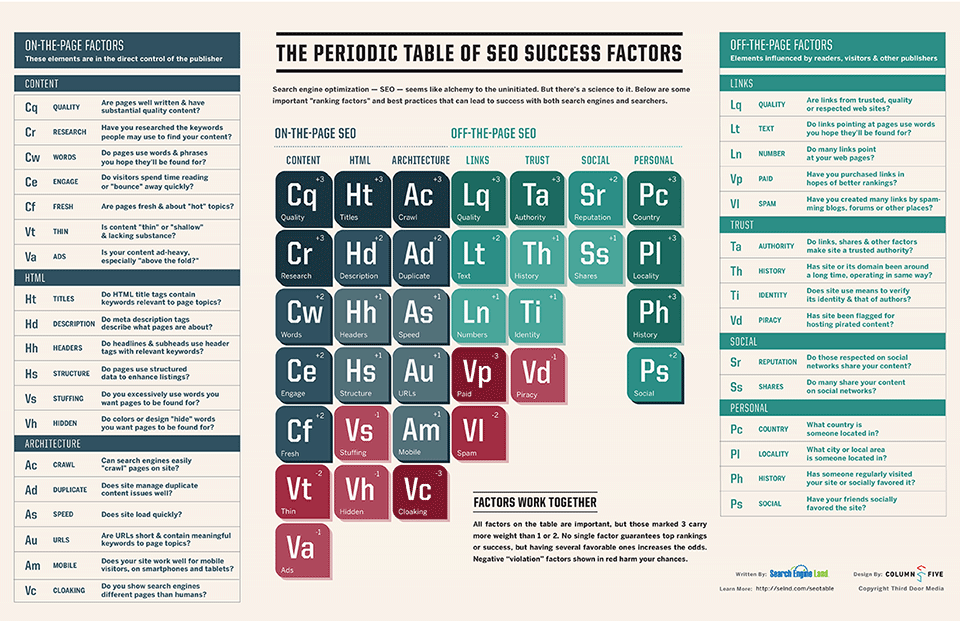1. Content focuses on depth and detail.
Once upon a time, 200-word posts updated several times a week were sufficient to achieve authority and page rank. Slowly but surely, 400 or 500-word posts became the new standard. While super informative, relevant short pieces will always hold some value, the trend is migrating toward super posts that are 1,000 to 2,000 words in length. In time, our site’s “Top 8” theme might have to grow to list the “Top 50” or “Top 100” ideas. With print media fading away, today’s internet reader has grown more comfortable with reading longer pieces online and they are looking for video, images and as much relevant, useful information as they can get.

Image Source: Search Engine Land
2. Content is becoming more diverse.
In addition to your standard blog entry, you will be expected to increase your content strategy to include infographics, videos, e-books and original images. The more you can maximize your appearance in search results — be it Google Images, a YouTube video search, Facebook’s new Graph Search, or Google itself — the more credibility your brand will have. Diversifying your methods of content dissemination will be crucial too. Instead of just re-posting a blog on your social media sites, you’ll need to look into adding a branded channel to YouTube, embedding unique images on Pinterest, and taking advantage of guest posting opportunities.
3. Google Authorship will play a bigger role.
Having a Google+ profile and linking to all the blogs you contribute to will greatly affect your search engine ranking, not to mention your street credibility. Google Authorship is a way of linking you to the entire body of what you’ve written online. You’ll be able to get a snapshot of your ranking, posting frequency and the quality of the sites you’re connected to. Establishing authority will not only come with the regular content you produce, but also any guest posting you do. That being said, you can bet Google is looking at guest posting as “the new article marketing,” so there will be pressure on site owners to check guest post articles for relevance and quality before approving them.
4. Quality links will become the only links that matter.
Link spammers are super annoying, aren’t they? Google’s Matt Cutts assures us that they’re developing more sophisticated algorithms to thwart these infernal pests. Paid advertorials and private blog networks will fade into obscurity, while link building will require less robotic automation and more ingenious human thought. The emphasis will be on relationship-building and reaching out to blog owners for mutual benefit.
5. Web design and user experience will continue to drive conversions.
People only trust professional-looking sites these days. Good design will propel visitors to sign up for a newsletter, buy a product, or share content. Navigation needs to be clear and effortless. Visitors will be looking for authority on your site. As a business owner, your name, face and story needs to be present on the website. You’ll need to chronicle important dates, memberships and awards that set your business apart from the competition.
6. Mobile performance should be more than an afterthought.
Having a lean mobile site that loads quickly is essential, says Google’s Matt Cutts. With more than half of all Americans surfing the web on their phones and iPads, mobile is no longer optional. You’ll need to invest some resources into ensuring that your mobile site works equally well on, say, an Android as it does the iPhone5. Mobile strategy is slightly different from web strategy. The emphasis is more on click-to-call, accessing maps to the nearest store, price checking, and being able to pull up more information about products found in-store. Many people use their mobile devices while shopping to aid in their decision making. They need to have the information they need easily accessible at a moment’s notice. Incorporating scan codes into product displays and product tags is likely to become more dominant in the years ahead.
7. Social signals will become more prominent.
It’s hard to believe people were questioning the staying power of social media just a few years ago. Now, with the addition of quintessential sites like Pinterest, Instagram and Google+, it seems the influence of social media is only growing. Branded social sites are in the forefront of any good content promotion strategy and the creation of exclusive social promotions and content will offer new opportunities for brands to skate ahead of their competitors.
8. SEO strategy trumps tactics.
The skills of coding and link-building are becoming less relevant, while more long-term strategies shift to the top of the game. What keywords and promotional avenues are most worth your while? Which websites are truly worth your links? Which content will draw the most views? What should your Pay-Per-Click budget be? How can you make your social sites stand out? More emphasis will be placed on how you string together your overall online efforts into a meaningful, forward-looking direction that produces results.




These points are the foundation of all successful digital Brands. Mandy your spot on with your questions in “8 SEO Strategy trumps tactics”. We like to think we ask ourselves these questions but do we really?